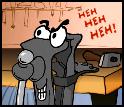|
|
| |
| |
|
|
|
|
|
|
|
|
| |
| |
| |
| |
| |
| |
| |
| |
| |
| |
|




| |
| |
|
Tell them you found it on anvilfire.com!
|
Anvils,
Amboß Amboss,
l'enclume,
incudine,
el yunque, bigornia,
städ,
incus,
aambeeld,
batente
наковальня
Two Vulcans
|
|

Image donated by his daughter, Polly Gnagy Seymore. Lighting corrected by Jock Dempsey
Who knew that the celebrated TV art instructor, Jon Gnagy, was a blacksmithing dreamer?
This slightly distorted painting is of a Peter Wright anvil as indicated by the flats on the feet and general shape.
Gnagy described himself as a blacksmith of art, and the above painting was one of his favorites.
Jon Gnagy, known to millions as America's television art teacher, was born at Varner's Forge, an outpost settlement near Pretty Prairie, Kansas in 1907.
The pioneer environment of his first seven years at the Forge and family farm reflect a strong influence in his work as an artist.
Son of Hungarian-Swiss Mennonites, Jon early developed inventive skills common to rural craftsmen.
At the age of eleven he began drawing and painting without instruction, winning sweepstake prizes at the Kansas State Fair in Hutchinson when he was 13 years old.
Gaining attention each year at the State Fair as the self-taught "blacksmith" of art, his vigorous compositions of the American Scene brought him an offer from Tulsa, Oklahoma.
When he was seventeen he accepted the position of art director with an industrial public relations organization in the Oil Capital, where he produced posters for the International Petroleum Exposition . . .
Gnagy became well prepared for his role as one of the country's greatest audio-visual educators when television started beaming to the public on May 13th, 1946.
His was the first performer on the first show the day the updated Channel 4 antenna (replacing NBC's old channel one antenna) was completed atop the Empire State Building.
Since then the grassroots blacksmith's name has become a household friend to millions of people.
The bolt stuck in the priticher hole may tell a story.
An abandonded anvil on its stump parked outside and seeing ocassional abuse.
Gnagy was a great influence on my young artistic life in the early 1960's.
His shows ran regularly on Saturday afternoons after the Saturday morning cartoons (Remember when TV life had a regular schedule?).
Gnagy's shows were the first info-mercials.
Once in the middle and at the end of the show Gnagy hawked his "Learn to Draw" kits.
This is what financed his shows for many years.
I had one of his kits and still have a couple of the pieces in my drawing box 60 years later.

Detail from painting
|

|
|





städ, incus, aambeeld, batente наковальня
Two Vulcans